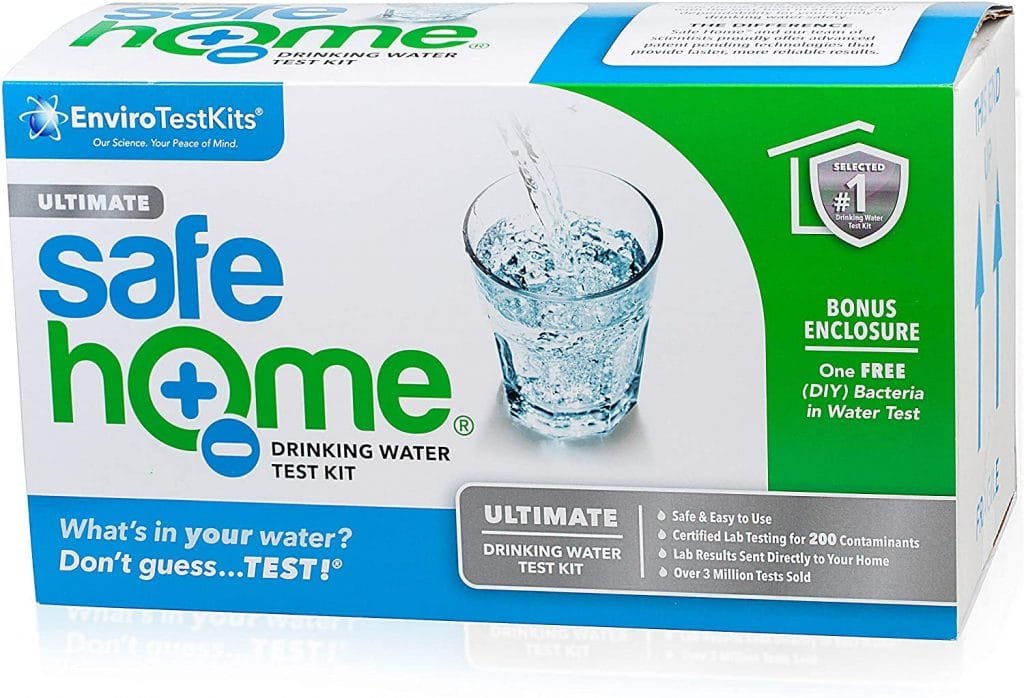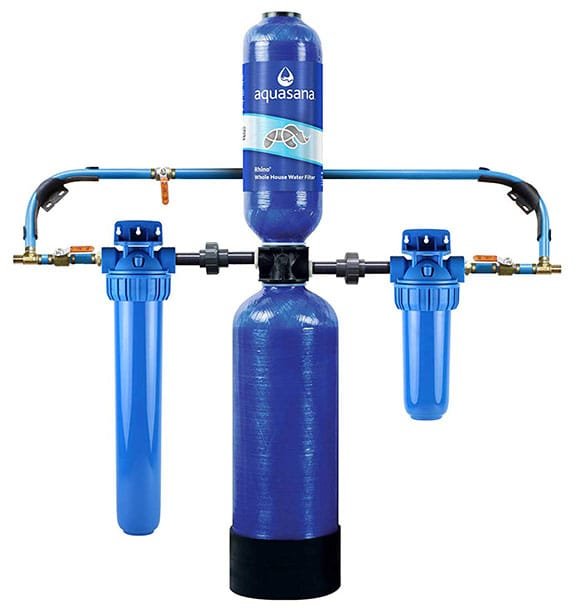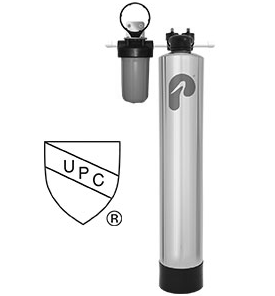Filteredwaterguide.com is supported by readers. If you purchase through referral links on our site, we make a commission at no extra cost to you. Learn more.

We’ve encountered numerous well water issues, but sulfur contamination stands out as one of the most noticeable problems.
The unmistakable rotten egg odor makes it instantly recognizable, and in cases of high concentration, you’ll definitely notice an unpleasant taste in your water.
We understand that no one wants their drinking water – or even shower water – to smell like rotten eggs.
Through our extensive testing and research, we’ve discovered effective methods to detect hydrogen sulfide and remove it from your water supply. Let us share our expert insights on eliminating sulfur from your well water.

Through our years of testing well water systems, we’ve identified two primary causes when that distinctive rotten egg smell appears in your water: sulfur bacteria growth or natural geological processes.
In our experience, sulfur bacteria is the more frequent offender. We’ve found that when coliform bacteria infiltrate well water, they consume sulfur for energy and produce hydrogen sulfide as a byproduct. This is what creates that unmistakable rotten egg odor every time you run your tap or start your shower.
The second cause we’ve encountered, though less common, stems from natural processes in the soil. During our investigations, we’ve seen how certain chemical reactions in the ground can naturally produce hydrogen sulfide. This gas then dissolves into groundwater and eventually makes its way into your well system.
In our professional assessment, whether the cause is natural geological processes or bacterial activity, hydrogen sulfide typically enters your water system through three main routes. Based on our field experience, the most common pathways are groundwater infiltration, rainwater seepage, or sulfur bacteria accumulation in your hot water heater.
During our inspections, we’ve consistently found that water heaters create ideal conditions for sulfur bacteria growth. The warm environment provides perfect breeding conditions, and we’ve noticed this is especially problematic in heaters that aren’t used regularly.
We’ve also discovered another significant source of hydrogen sulfide: magnesium anode rods in water heaters. Through our testing, we’ve observed that when soft water regularly flows through the heater, it can gradually break down these magnesium rods, resulting in hydrogen sulfide production.
In our field work, we’ve found that the most prevalent source of sulfur contamination comes from natural ground sources. We’ve observed how rainwater and groundwater naturally filter through soil, rocks, and decomposing organic matter, collecting various elements – including sulfur – along their journey.
While our testing shows that trace amounts of sulfur aren’t typically problematic, we’ve learned that when you can smell or taste it, that’s a clear sign the concentration has exceeded acceptable levels.

As the Filtered Water Guide team, we’ve extensively studied and analyzed the effects of hydrogen sulfide in well water systems. While not immediately dangerous, our research shows that untreated sulfur in well water can lead to several concerning issues over time.
Through our investigations, we’ve found that high sulfur concentrations can have a laxative-like effect on the digestive system. Our team has documented cases where this leads to diarrhea and potential dehydration in sensitive individuals. While some people’s bodies may eventually adjust to higher sulfur levels, we strongly recommend addressing the issue rather than risking these uncomfortable symptoms.
In our professional inspections, we’ve consistently observed how sulfur-rich water attacks metal components in plumbing systems. The chemical reaction between sulfur and metals like steel and iron causes significant deterioration over time. We’ve also noticed that sulfur-contaminated water leaves stubborn black stains on laundry and causes noticeable discoloration on metal utensils and fixtures.
One of the most serious issues we encounter is the relationship between sulfur and iron bacteria. Our field tests have shown that elevated hydrogen sulfide levels create ideal conditions for these bacteria to thrive. These organisms form thick, slimy deposits that we often find coating pipe walls and pump components. In severe cases we’ve investigated, these bacterial colonies have completely blocked water flow, drastically reducing well output or shutting down systems entirely.
Beyond the physical and mechanical problems, we’ve found that the notorious “rotten egg” smell of hydrogen sulfide significantly impacts quality of life. Through our consultations with homeowners, we’ve learned that this persistent odor often makes well water unusable for everyday activities like drinking and bathing. The smell isn’t just unpleasant – it can permeate your entire home, making living spaces uncomfortable and potentially affecting property value.
While that distinctive rotten egg smell is a clear warning sign of sulfur contamination, our team has identified several other indicators that signal the need for testing. Through our extensive field experience, we’ve observed that persistent discoloration of dishes, unexplained laundry stains, and recurring plumbing clogs often point to elevated sulfur levels.
For initial screening, we typically recommend using a reliable water testing kit. These kits are designed to detect various common contaminants, including sulfur, iron, and manganese. The process is straightforward – simply use the provided test strips according to the instructions, and you’ll have preliminary results within minutes.
When we test your water, we always sample both hot and cold water sources. This dual-testing approach has proven crucial in our diagnostic process. Understanding which water supply contains sulfur helps pinpoint the contamination source. For example, our testing experience shows that sulfur present only in hot water often indicates a water heater issue, while sulfur in both hot and cold supplies typically suggests a well system problem.
While home testing kits serve as useful screening tools, we’ve found that laboratory analysis provides more comprehensive results. Though more expensive, professional laboratory testing delivers precise measurements of hydrogen sulfide levels. In our professional opinion, this detailed information is invaluable for developing an effective treatment strategy.
Based on our extensive testing and treatment experience, removing hydrogen sulfide from well water requires a systematic approach. After conducting either laboratory analysis or home testing, our team has identified several proven methods for sulfur removal. Drawing from our hands-on experience treating numerous well systems, we’ll share the three most effective solutions we’ve implemented.
Through our field testing, we’ve discovered that water with extremely high sulfur concentrations (exceeding 6 mg/l) responds best to chemical treatment methods. Our team regularly implements solutions using chlorine bleach or hydrogen peroxide, which effectively deoxidize sulfur compounds. We’ve successfully used this same approach when treating water with elevated manganese or iron levels.
The benefits extend beyond sulfur removal – we’ve observed that these chemical treatments also eliminate the characteristic rotten egg odor that plagues many well systems.
For chemical treatment implementation, we recommend installing a chlorine chemical feed pump into your well system. These sophisticated devices automatically measure and dispense precise amounts of chlorine or hydrogen peroxide based on your water’s needs. Some models we’ve worked with offer customizable chlorine levels for more precise control.
The system operates through a storage tank mechanism, where treated water is kept ready for use. We’ve found this setup particularly efficient as it automatically replenishes itself with fresh well water as needed.

For wells with sulfur levels under 6 mg/l, we’ve had excellent results using oxidizing media filters (also known as aeration or air injection treatments). Based on our extensive testing, these systems provide an effective solution for both sulfur and iron removal.
The process we’ve implemented countless times works through a simple yet brilliant mechanism: the filter oxidizes hydrogen sulfide gas, converting it to solid sulfur particles that become trapped in the filter media. Through our testing, we’ve confirmed that these insoluble particles cannot pass through the filter, ensuring your drinking water remains sulfur-free.
From our maintenance experience, we should note that these systems do require regular upkeep, including periodic regeneration with potassium permanganate solution.
For specific product recommendations, you can explore our curated lists of best well water filters or best sulfur water filters that feature air injection oxidation technology.

For wells with sulfur levels under 6 mg/l, we’ve had excellent results using oxidizing media filters (also known as aeration or air injection treatments). Based on our extensive testing, these systems provide an effective solution for both sulfur and iron removal.
The process we’ve implemented countless times works through a simple yet brilliant mechanism: the filter oxidizes hydrogen sulfide gas, converting it to solid sulfur particles that become trapped in the filter media. Through our testing, we’ve confirmed that these insoluble particles cannot pass through the filter, ensuring your drinking water remains sulfur-free.
From our maintenance experience, we should note that these systems do require regular upkeep, including periodic regeneration with potassium permanganate solution.
For specific product recommendations, you can explore our curated lists of best well water filters or best sulfur water filters that feature air injection oxidation technology.
Through our diagnostic work, we’ve found that sometimes sulfur problems originate in the water heater – specifically with the magnesium anode rod. In these cases, our team recommends replacing the magnesium rod with an alternative material. This is crucial: we always ensure the replacement rod isn’t magnesium to prevent future sulfate formation through chemical reaction.
In our most challenging cases, particularly those involving extremely high groundwater sulfur levels resistant to chemical treatment, we sometimes recommend drilling a new well in a different geological formation. While this represents a significant undertaking, our experience has shown it’s occasionally the only viable long-term solution for severe contamination cases.

Based on our years of experience treating well water systems, we’ve compiled answers to the most common questions our team receives about sulfur contamination. Here’s what you need to know.
In our extensive experience treating well water systems, we’ve found that there’s no one-size-fits-all solution for sulfur removal. The best treatment method depends on your specific situation and sulfur concentration levels.
For wells with extremely high sulfate levels, our team typically recommends chemical treatments. In severe cases where treatment proves ineffective, we may suggest drilling a new well as a last resort.
However, we’ve successfully treated moderate to low sulfur levels using oxidizing media filters, while minimal contamination often responds well to activated carbon filtration.
An important consideration: Our testing frequently reveals multiple contaminants present simultaneously. We’ve found that certain treatment methods offer dual benefits – for instance, media filters effectively address both sulfur and iron issues, while chemical treatments can tackle sulfur, iron, and manganese simultaneously.
Through our field experience, we’ve noticed that many homeowners wait until they detect the telltale rotten egg smell before testing for sulfur. However, our research shows this reactive approach isn’t ideal. We’ve discovered that sulfur can be present at lower concentrations without producing noticeable odors.
Based on our professional expertise, we strongly recommend annual testing of private wells and water heaters for sulfur and other common contaminants, regardless of whether you notice any obvious signs of contamination.
While the distinctive rotten egg odor is the most recognized sign, our team has identified several other reliable indicators of sulfur presence in well water:
These signs often appear before the sulfur concentration becomes high enough to produce the characteristic smell.
As the Filtered Water Guide team, we understand that managing sulfur contamination in well water can feel overwhelming, especially for first-time well owners. While we’ve provided comprehensive guidance based on our extensive experience, we always recommend consulting your local Department of Health for specific treatment recommendations tailored to your area.
Can’t pinpoint the sulfur source? Our years of field experience have shown that a professional inspection by a certified specialist can save both time and resources in the long run. They can precisely identify the contamination source and recommend the most effective treatment approach for your specific situation.